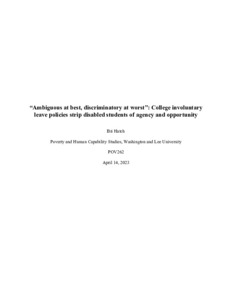| dc.rights.license | In Copyright | en_US |
| dc.creator | Hatch, Brianna | |
| dc.date.accessioned | 2023-04-25T14:49:34Z | |
| dc.date.available | 2023-04-25T14:49:34Z | |
| dc.date.created | 2023 | |
| dc.identifier | WLURG038_Hatch_POV_2023 | |
| dc.identifier.uri | https://dspace.wlu.edu/handle/11021/36209 | |
| dc.description | Capstone; [FULL-TEXT FREELY AVAILABLE ONLINE] | en_US |
| dc.description | Brianna Hatch is a member of the Class of 2023 of Washington and Lee University. | en_US |
| dc.description.abstract | For college students with mental health conditions that manifest in self-harm or suicidal ideation, . . . the fear of being forced to withdraw from courses and leave campus is everpresent. Many colleges employ policies that can place struggling students on medical leave involuntarily. But the language used and criteria followed varies greatly, limiting transparency and clarity. Students therefore lack the ability to make informed decisions -- and fear seeking help altogether because of the threat of forced removal. And when students try to re-enroll after mandatory leaves, they face harsh and demanding return policies filled with contingencies and requirements. These policies ultimately limit the educational attainment opportunities of students with disabilities, while violating their autonomy and potentially endangering them further by not considering individualized circumstances. As one study put it, college policies about involuntary leave are "ambiguous at best and discriminatory at worst"[5]. Of the top 100 colleges in the country, fifty-four have involuntary leave policies[6]. Seventy percent of these colleges specifically cite self-harm or risk to self as justification for
involuntary removal. Thirty-seven percent take away entitlement to financial aid when students are on forced leave. Thirty percent bar removed students from even setting foot on campus. One study led by The Ruderman Foundation, a group focused on suicide prevention, graded the involuntary leave policies at the Ivy League schools -- and none of them earned higher than a D+[7]. Some policies contain language that describes suicidal thoughts or self-harm as "immature or a potential cause for punishment by the university," which further stigmatizes students with mental health conditions and deters them from reaching out for help[8]. [From introductory section] | en_US |
| dc.description.statementofresponsibility | Bri Hatch | |
| dc.language.iso | en_US | en_US |
| dc.rights | This material is made available for use in research, teaching, and private study, pursuant to U.S. Copyright law. The user assumes full responsibility for any use of the materials, including but not limited to, infringement of copyright and publication rights of reproduced materials. Any materials used should be fully credited with the source. | en_US |
| dc.rights.uri | http://rightsstatements.org/vocab/InC/1.0/ | en_US |
| dc.subject.other | Washington and Lee University, Shepherd Poverty Program | en_US |
| dc.title | "Ambiguous at best, discriminatory at worst": College Involuntary Leave Policies Strip Disabled Students of Agency and Opportunity | en_US |
| dc.type | Text | en_US |
| dcterms.isPartOf | RG38 - Student Papers | |
| dc.rights.holder | Hatch, Brianna | |
| dc.subject.fast | College students -- Mental health services | en_US |
| dc.subject.fast | Mental health policy | en_US |
| dc.subject.fast | Crisis intervention (Mental health services) | en_US |
| local.department | Shepherd Poverty Program | en_US |
| local.scholarshiptype | Capstone | en_US |
